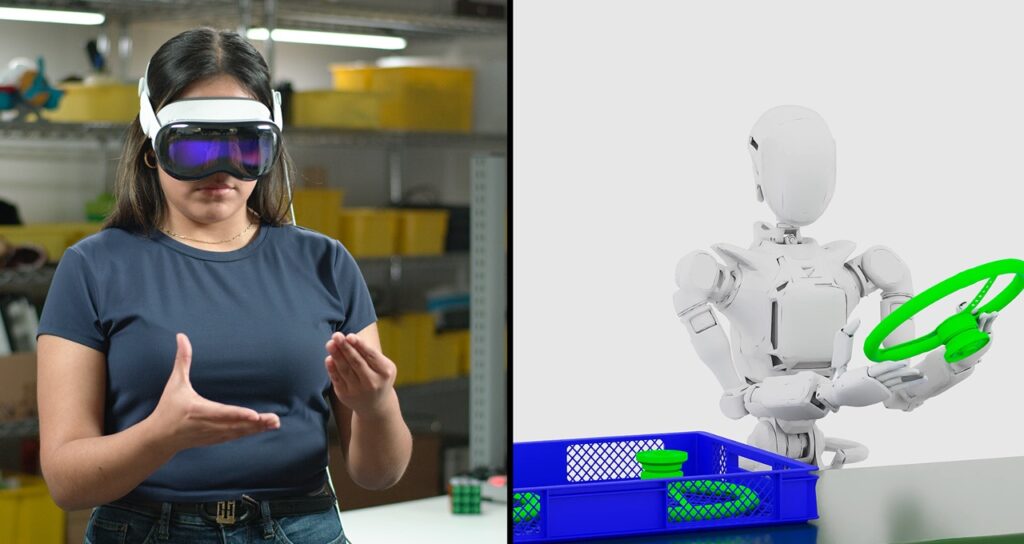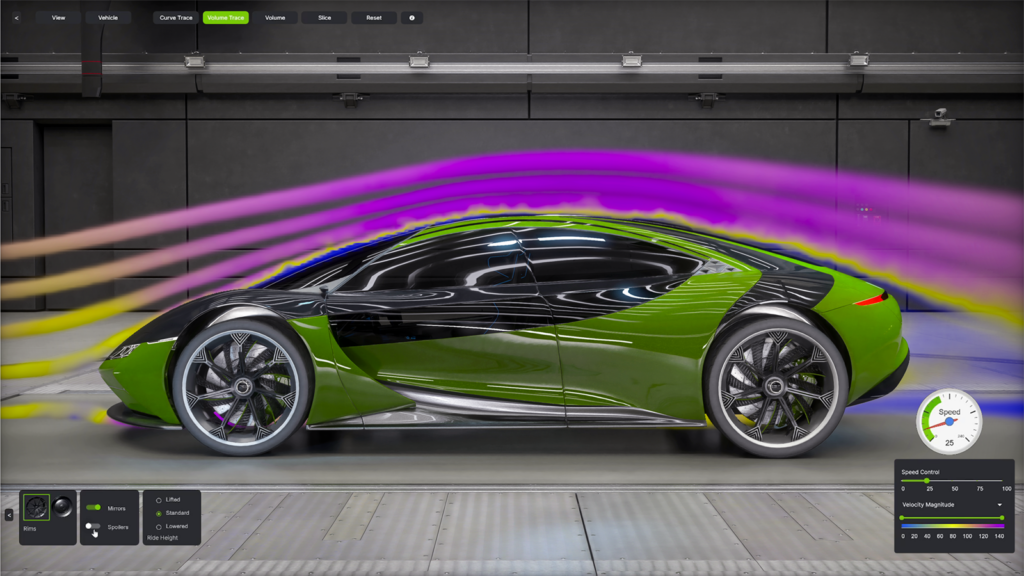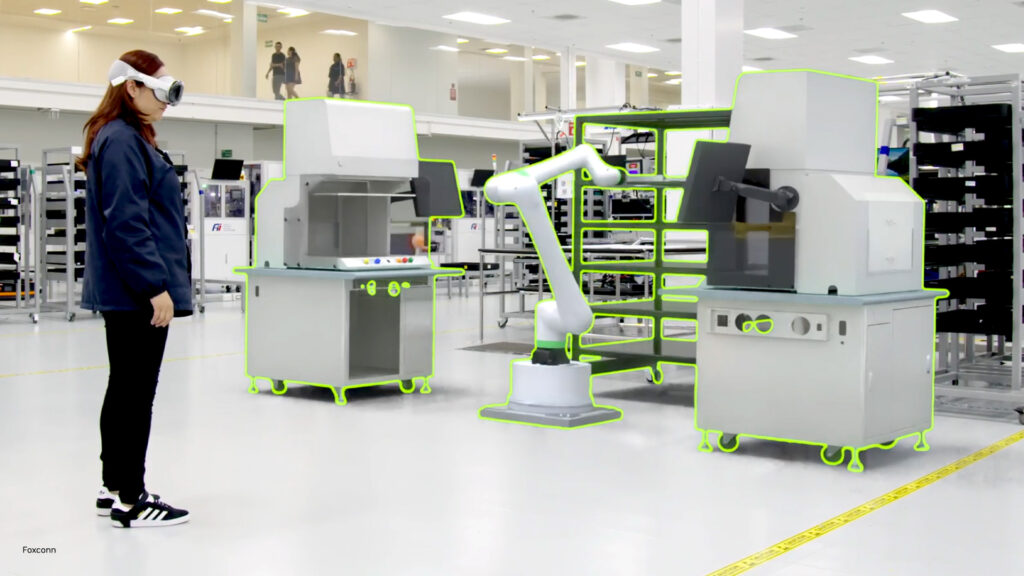In the rapidly evolving fields of extended reality (XR) and 3D visualization, NVIDIA Omniverse stands out as a groundbreaking platform that combines real-time collaboration, advanced simulation, and cutting-edge visualization. Built on Pixar’s Universal Scene Description (USD) framework, Omniverse bridges the gap between various 3D applications, offering unparalleled opportunities in the XR space, including industrial sectors.
NVIDIA Omniverse from the XR standpoint
-
But what is NVIDIA Omniverse?
In general terms, Omniverse is a collection of technology and services allowing customers to integrate them into existing software, enriching the experience in various ways. This may include collaborative 3D design, simulation, and visualization. Leveraging NVIDIA’s expertise in GPU technology, Omniverse integrates real-time ray tracing, AI-driven tools, and physics simulations to create a unified environment where users can share and collaborate seamlessly on complex 3D projects and manage content.
The stand-out feature specific to industrial use is its interoperability with various 3D design platforms, such as Maya, Blender, Unreal Engine, Unity and CAD software in general, streamlining pipelines from modelling to collaboration and visualization.
-
How does this translate into XR applications?
There are two major challenges when it comes to leveraging 3D content for XR applications: optimization and content management.
- Optimization
One significant challenge lies in the complexity of 3D models. Industrial models are often highly detailed digital twins of real-world products, complete with intricate features such as individual bolts, IoT data, and simulation outputs. This level of detail can lead to substantial performance issues, even on high-end desktop workstations, let alone standalone XR headsets. While optimization tools are available, preparing large-scale models for XR applications can be a time-intensive process, often consuming valuable man-days, particularly when the original models were not designed with XR in mind. A game-changing solution to this issue comes from Hololight, a company fully integrated with NVIDIA Omniverse. Their software, Space, leverages cutting-edge remote rendering technology to eliminate the need for model optimization entirely.

This approach allows even the most complex models to be visualized seamlessly, whether hosted in the cloud or on-premise. By offloading computational demands, Space pushes the boundaries of what can be rendered in XR, enabling teams to work more efficiently and focus on innovation rather than technical limitations.

- Content management
One of the significant challenges companies encounter is the management of data sharing, version control, and access rights for 3D models. Consider a scenario where the production department requires a 3D model for factory layout planning. Typically, this process involves several steps: the production team requests the model from a CAD engineer, who then exports it into a compatible format and optimizes it for visualization purposes. Afterward, the file is uploaded to the designated software, followed by rendering and visualization. This multi-step process is not only time-consuming but can also take several man-days to complete. Now imagine multiple departments requiring similar models for their respective tasks. Expecting a single CAD engineer to continuously optimize and export models for each request while simultaneously managing their primary responsibilities quickly becomes unfeasible. With NVIDIA Omniverse, however, this challenge can be addressed through a unified CAD data storage system that streamlines the entire workflow.
Access rights and model versions are centrally managed, ensuring the right data is available to the right people for specific purposes. The CAD engineer simply saves the model to the Omniverse platform, where pre-configured administrative settings take care of access control, versioning, and optimization. This approach not only accelerates the process but also fosters collaboration across departments without overburdening key personnel.
Interested in more?
Feel free to contact us. We will help you find the right solution.
Additional uses cases for NVIDIA Omniverse
As mentioned previously, Omniverse is a collection of different technologies, allowing them to be integrated into practically any software. With that in mind, the potential for revolutionizing your XR game is tremendous.
Design and engineering teams can work on complex products, for instance, team members can collaboratively review designs in an immersive environment, make annotations, and suggest changes in real-time, regardless of their physical location. Training centers can train employees on complex machinery or operational procedures without exposing them to actual hazards. Thanks to this approach, trainees can experience realistic simulations with real-world physics, IoT data integration, and even real-time feedback within XR headsets.
Sales teams can leverage XR to showcase complex products to customers in an engaging and interactive way without transporting physical prototypes.

Customers can interact with digital twins, explore features, and experience the product in context, such as a factory or a home setting.
Manufacturing facilities can leverage Omniverse to optimize layouts without interrupting operations. The teams can use visualization in XR, using real-time data to simulate the placement of 3D models and flow of equipment, materials, and personnel. Changes can be previewed in a collaborative environment to identify bottlenecks or inefficiencies before implementation.
This technology offers a wide range of applications across multiple departments, making NVIDIA Omniverse not only highly valuable but also potentially transformative for nearly any industrial organization.
In conclusion, NVIDIA Omniverse is reshaping the landscape of XR and 3D visualization with its ability to unify workflows, optimize collaboration, and push the boundaries of what’s possible with digital twins and immersive environments. By addressing key challenges such as model complexity and content management, it empowers industries to innovate faster and work more efficiently. From design reviews and training simulations to product demonstrations and beyond, Omniverse bridges the gap between imagination and implementation, unlocking new levels of creativity and productivity. As the technology continues to evolve, its potential to revolutionize XR applications will only grow, making it an indispensable tool for businesses looking to stay ahead in a competitive and rapidly advancing world.

